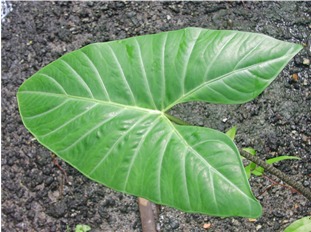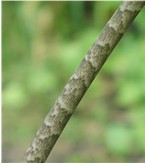









Aroids III
Alocasias and Colacasia
Alocasia comprises of about 60 species distributed in East Asia and Australasia. They are popular horticultural subjects for a long time due to their interesting foliage - both the leaves and sometimes, stems. Some are also widely grown for food in the tropics and one species, A. denudata from the lowii complex is also a constituent of the arrow poison amongst the Malaysian tribes. Colacasia is a related genus comprising of many important food plants grown in warm tropics.
|
|
This may well be the new species Alocasia stoloniferous as proposed by Peter Boyce, but I have not seen any inflorescence yet. It was obtained from Thailand and is the only truly deciduous species I have. |
|
|
Alocasia lauterbachiana from PNG. This has a rather unique leaves and was once placed in a separate genus, Xenophya. |
|
|
Alocasia cuprea originates from Borneo - visitors to Mount Kinabalu in Sabah will proably see this plants quite often around the park HQ. |
|
|
Alocasia scalprum was originally found growing by residents on Samar Island in The Philippines. It is a small plant with tough dark coloured textured leaves. |
|
|
Alocasia denudata - this is lumped under the longiloba complex by Alistair Hay. It is a common plant in Singapore, Malaysia and Borneo and has attractive snakeskin petiole. Unlike most lowii, the underside of the leaves are not purple coloured. It can be found growing in the lowlands usually by streams or areas that experience short period of floods during rainy season. Ths plant is known to be eaten by indigenous people after proper cooking. |
|
|
Alocasia sanderiana var nobilis is a beautiful plant from Mindanao, Philippines where it is probably extinct or very rare. The highly indented leaf margin is supposed to break the outline of the plant and discourage herbivores. This is one of the parent of the well known hybrid A. x Amazonica, the other being A. lowii. |
|
|
Alocasia reginula is a striking and rare plant from Borneo - the interesting part is nobody has ever reported it in the wild and its exact habitat remains a mystery - the original population was from Lyon Arboretum in Hawaii which in turn got it from a Japanese collector in Borneo. Nevertheless, due to micropropagation in USA, it is now a fairly common plant in the trade under the name "Black Velvet". |
|
|
This is the smallest Alocasia I have come across, known by the horticulture name A. "Fantasy". |
|
|
Colacasia gigantea is a massive plant with very architectural large leaves. |